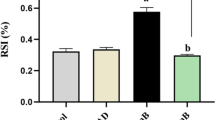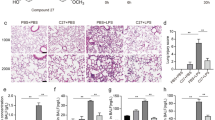Abstract
Acute hepatic failure remains an extremely poor prognosis and still results in high mortality. Therefore, better treatment is urgently needed. Melittin, a major component of bee venom, is known to inhibit inflammatory reactions induced by lipopolysaccharide (LPS) or tumor necrosis factor (TNF)-α in various cell types. However, there is no evidence of the anti-inflammatory and anti-apoptotic effect of melittin on liver cells. In the present study, we investigated the effects of melittin on d-galactosamine (GalN)/lipopolysaccharide (LPS)-induced acute hepatic failure. Acute liver injury was induced with GalN/LPS to determine in vivo efficacy of melittin. Mice were randomly divided into four groups: sterile saline treated group (NC), melittin only treated group (NM), GalN/LPS-treated group (GalN/LPS), and GalN/LPS treated with melittin group (M+GalN/LPS). Mice were given intraperitoneal GalN/LPS with or without melittin treatment. Liver injury was assessed biochemically and histologically. Inflammatory cytokines in the serum, apoptosis of hepatocytes, and cleavage of caspase-3 in the liver were determined. The expression of TNF-α and interleukin (IL)-1β were increased in the GalN/LPS group. However, treatment of melittin attenuated the increase of inflammatory cytokines. The M+GalN/LPS group showed significantly fewer apoptotic cells compared to the GalN/LPS group. Melittin significantly inhibited the expression of caspase and bax protein levels as well as cytochrome c release in vivo. In addition, melittin prevented the activation of the transcription factor nuclear factor-kappa B (NF-κB) induced by GalN/LPS. These results clearly indicate that melittin provided protection against GalN/LPS-induced acute hepatic failure through the inhibition of inflammatory cytokines and apoptosis.






Similar content being viewed by others
Abbreviations
- TNF-α:
-
Tumor necrosis factor
- GalN:
-
d-Galactosamine
- LPS:
-
Lipopolysaccharide
- i.p.:
-
Intraperitoneal
- IL-1β:
-
Interleukin
- NF-κB:
-
Nuclear factor-kappa B
- ALT:
-
Alanine aminotransferase
- VSMC:
-
Vascular smooth muscle cell
- MAPK:
-
Mitogen-activated protein kinases
- EMSA:
-
Electrophoretic mobility shift analysis
- IHC:
-
Immunohistochemistry
- TUNEL:
-
Terminal deoxynucleotidyl transferase-mediated deoxyuridine triphosphate-digoxigenin nick-end labeling
References
Choi EY, Hwang HJ, Kim IH, Nam TJ (2009) Protective effects of a polysaccharide from Hizikia fusiformis against ethanol toxicity in rats. Food Chem Toxicol 47:134–139
Sun H, Chen L, Zhou W, Hu L, Li L, Tu Q et al (2011) The protective role of hydrogen-rich saline in experimental liver injury in mice. J Hepatol 54:471–480
Kim SH, Kim YS, Kang SS, Bae K, Hung TM, Lee SM (2008) Anti-apoptotic and hepatoprotective effects of gomisin A on fulminant hepatic failure induced by d-galactosamine and lipopolysaccharide in mice. J Pharmacol Sci 106:225–233
Nakama T, Hirono S, Moriuchi A, Hasuike S, Nagata K, Hori T et al (2001) Etoposide prevents apoptosis in mouse liver with d-galactosamine/lipopolysaccharide-induced fulminant hepatic failure resulting in reduction of lethality. Hepatology 33:1441–1450
Pathil A, Warth A, Chamulitrat W, Stremmel W (2011) The synthetic bile acid-phospholipid conjugate ursodeoxycholyl lysophosphatidylethanolamide suppresses TNFalpha-induced liver injury. J Hepatol 54:674–684
Silverstein R (2004) d-galactosamine lethality model: scope and limitations. J Endotoxin Res 10:147–162
Sass G, Heinlein S, Agli A, Bang R, Schumann J, Tiegs G (2002) Cytokine expression in three mouse models of experimental hepatitis. Cytokine 19:115–120
Gong X, Luo FL, Zhang L, Li HZ, Wu MJ, Li XH et al (2010) Tetrandrine attenuates lipopolysaccharide-induced fulminant hepatic failure in D-galactosamine-sensitized mice. Int Immunopharmacol 10:357–363
Osawa Y, Banno Y, Nagaki M, Brenner DA, Naiki T, Nozawa Y et al (2001) TNF-alpha-induced sphingosine 1-phosphate inhibits apoptosis through a phosphatidylinositol 3-kinase/Akt pathway in human hepatocytes. J Immunol 167:173–180
Yoshida T, Abe K, Ikeda T, Matsushita T, Wake K, Sato T et al (2007) Inhibitory effect of glycyrrhizin on lipopolysaccharide and d-galactosamine-induced mouse liver injury. Eur J Pharmacol 576:136–142
Yamada I, Goto T, Takeuchi S, Ohshima S, Yoneyama K, Shibuya T et al (2008) Mao (Ephedra sinica Stapf) protects against d-galactosamine and lipopolysaccharide-induced hepatic failure. Cytokine 41:293–301
Wong CW, Seow WK, O’Callaghan JW, Thong YH (1992) Comparative effects of tetrandrine and berbamine on subcutaneous air pouch inflammation induced by interleukin-1, tumour necrosis factor and platelet-activating factor. Agents Actions 36:112–118
Camussi G, Albano E, Tetta C, Bussolino F (1991) The molecular action of tumor necrosis factor-alpha. Eur J Biochem 202:3–14
Eipel C, Bordel R, Nickels RM, Menger MD, Vollmar B (2004) Impact of leukocytes and platelets in mediating hepatocyte apoptosis in a rat model of systemic endotoxemia. Am J Physiol Gastrointest Liver Physiol 286:G769–G776
Jaeschke H, Fisher MA, Lawson JA, Simmons CA, Farhood A, Jones DA (1998) Activation of caspase 3 (CPP32)-like proteases is essential for TNF-alpha-induced hepatic parenchymal cell apoptosis and neutrophil-mediated necrosis in a murine endotoxin shock model. J Immunol 160:3480–3486
Riedemann NC, Guo RF, Ward PA (2003) Novel strategies for the treatment of sepsis. Nat Med 9:517–524
Raghuraman H, Chattopadhyay A (2007) Melittin: a membrane-active peptide with diverse functions. Biosci Rep 27:189–223
Wang C, Chen T, Zhang N, Yang M, Li B, Lü X et al (2009) Melittin, a major component of bee venom, sensitizes human hepatocellular carcinoma cells to tumor necrosis factor-related apoptosis-inducing ligand (TRAIL)-induced apoptosis by activating CaMKII-TAK1-JNK/p38 and inhibiting IkappaBalpha kinase-NFkappaB. J Biol Chem 284:3804–3813
Park JH, Kim KH, Kim SJ, Lee WR, Lee KG, Park KK (2010) Bee venom protects hepatocytes from tumor necrosis factor-alpha and actinomycin D. Arch Pharm Res 33:215–223
Kim SJ, Park JH, Kim KH, Lee WR, Chang YC, Park KK et al (2010) Bee venom inhibits hepatic fibrosis through suppression of pro-fibrogenic cytokine expression. Am J Chin Med 38:921–935
Lee WR, Kim SJ, Park JH, Kim KH, Chang YC, Park YY et al (2010) Bee venom reduces atherosclerotic lesion formation via anti-inflammatory mechanism. Am J Chin Med 38:1077–1092
Jesse CR, Wilhelm EA, Bortolatto CF, Savegnago L, Nogueira CW (2009) Selective blockade of mGlu5 metabotropic glutamate receptors is hepatoprotective against fulminant hepatic failure induced by lipopolysaccharide and d-galactosamine in mice. J Appl Toxicol 29:323–329
Park JH, Jo JH, Kim KH, Kim SJ, Lee WR, Park KK et al (2009) Antifibrotic effect through the regulation of transcription factor using ring type-Sp1 decoy oligodeoxynucleotide in carbon tetrachloride-induced liver fibrosis. J Gene Med 11:824–833
Arvelo MB, Cooper JT, Longo C, Daniel S, Grey ST, Mahiou J et al (2002) A20 protects mice from d-galactosamine/lipopolysaccharide acute toxic lethal hepatitis. Hepatology 35:535–543
Park HJ, Lee SH, Son DJ, Oh KW, Kim KH, Song HS et al (2004) Antiarthritic effect of bee venom: inhibition of inflammation mediator generation by suppression of NF-kappaB through interaction with the p50 subunit. Arthritis Rheum 50:3504–3515
Park HJ, Son DJ, Lee CW, Choi MS, Lee US, Song HS et al (2007) Melittin inhibits inflammatory target gene expression and mediator generation via interaction with IkappaB kinase. Biochem Pharmacol 73:237–247
Kasai S, Kakisaka A, Kudo K, Mito M (1996) Protective effects of dibutyryl cyclic AMP on acute hepatic failure in rats. J Surg Res 66:75–80
Santucci L, Fiorucci S, Chiorean M, Brunori PM, Di Matteo FM, Sidoni A et al (1996) Interleukin 10 reduces lethality and hepatic injury induced by lipopolysaccharide in galactosamine-sensitized mice. Gastroenterology 111:736–744
Lee WC, Kim JK, Kang JW, Oh WY, Jung JY, Kim YS et al (2009) Palmatine attenuates d-galactosamine/lipopolysaccharide-induced fulminant hepatic failure in mice. Food Chem Toxicol 48:222–228
Xiong Q, Hase K, Tezuka Y, Namba T, Kadota S (1999) Acteoside inhibits apoptosis in d-galactosamine and lipopolysaccharide-induced liver injury. Life Sci 65:421–430
Wang H, Xu DX, Lv JW, Ning H, Wei W (2007) Melatonin attenuates lipopolysaccharide (LPS)-induced apoptotic liver damage in d-galactosamine-sensitized mice. Toxicology 237:49–57
Kim WH, Hong F, Radaeva S, Jaruga B, Fan S, Gao B (2003) STAT1 plays an essential role in LPS/d-galactosamine-induced liver apoptosis and injury. Am J Physiol Gastrointest Liver Physiol 285:G761–G768
Liu D, Liu XY, Robinson D, Burnett C, Jackson C, Seele L et al (2004) Suppression of staphylococcal enterotoxin B-induced toxicity by a nuclear import inhibitor. J Biol Chem 279:19239–19246
Wullaert A, van Loo G, Heyninck K, Beyaert R (2007) Hepatic tumor necrosis factor signaling and nuclear factor-kappaB: effects on liver homeostasis and beyond. Endocr Rev 28:365–386
Zou H, Li Y, Liu X, Wang X (1999) An APAF-1 cytochrome c multimeric complex is a functional apoptosome that activates procaspase-9. J Biol Chem 274:11549–11556
Yamada Y, Kirillova I, Peschon JJ, Fausto N (1997) Initiation of liver growth by tumor necrosis factor: deficient liver regeneration in mice lacking type I tumor necrosis factor receptor. Proc Natl Acad Sci USA 94:1441–1446
Uchida Y, Kaibori M, Hijikawa T, Ishizaki M, Ozaki T, Tanaka H et al (2008) Protective effect of neutrophil elastase inhibitor (FR136706) in lethal acute liver failure induced by d-galactosamine and lipopolysaccharide in rats. J Surg Res 145:57–65
Kaibori M, Yanagida H, Yokoigawa N, Kwon AH, Okumura T, Kamiyama Y (2004) Effect of pirfenidone on induction of chemokines in rat hepatocytes. Transplant Proc 36:1980–1984
Wullaert A, Heyninck K, Beyaert R (2006) Mechanisms of crosstalk between TNF-induced NF-kappaB and JNK activation in hepatocytes. Biochem Pharmacol 72:1090–1101
Acknowledgments
This work was supported by a grant (PJ0081302011) from the BioGreen 21 Program, Rural Development Administration, and Republic of Korea.
Author information
Authors and Affiliations
Corresponding author
Rights and permissions
About this article
Cite this article
Park, JH., Kim, KH., Lee, WR. et al. Protective effect of melittin on inflammation and apoptosis in acute liver failure. Apoptosis 17, 61–69 (2012). https://doi.org/10.1007/s10495-011-0659-0
Published:
Issue Date:
DOI: https://doi.org/10.1007/s10495-011-0659-0




